Caring for ‹Me and the Other›: Artistic Cannibalism
by Mira Hirtz
Menschlichkeit1 denominates a value. The term humankind or Menschheit is mostly used as a generic name whereas Menschlichkeit is a normative one: It generates a sense of common bond, something one can call upon, something that can be missed by human beings. As Menschlichkeit is normative, it is something to be set by human beings, and therefore it will hardly ever be a finite concept but a process of constant negotiation – which doesn’t make it less important. Because not only the question about which values one should aim for is a crucial neverlasting topic, but also the related issue of in and exclusion: the relation of ‹me and the other›.
‹Me and the other›, this phrase has a long tradition in philosophy and culture theory as well as in politics, psychoanalysis, art etc. ‹Me and the other› does not only mean interpersonal relations, but it is a broader concept of dualities: inside and outside, the familiar and the foreign, the true and the false, safety and danger. It refers to an international political relation between countries, a power relation between cultures, a relation between individuals, between subject and object, the relation to myself. And it impli cates a lot of unsolved questions: Are the relations characterized by de pendency or independency? Which kind of ‹me› refers to what kind of defined ‹other›? Is this separation and differentiation possible, and further, legitimate or even necessary?
In this article, I will look at examples of artistic cannibalism as a manifestation of and reflection about the ‹me and the other› phenomenon.The following will mostly refer to Brazilian art. In three chapters I will show that, by dealing with the relation of ‹me and the other›, the specific practice of artistic cannibalism is questioning conventional normative values. I posit that art is a place of negotiating and caring for Menschlichkeit.
The idea that artistic practice is able to question, reflect and care for such fundamental social topics as Menschlichkeit has also been depicted by Joseph Kosuth. In 1975 he described the artist as an ‹engaged anthropologist›2: The artist has, just as the anthropologist, an overview but does, different to the anthropologist, alter what she/he investigates. Hers/his role is thereby situated in theory and in practice. In Kosuth’s view the scientist is always disengaged, but the artist cannot be neutral. The latter is eager to ‹obtain fluently› in a society that she/he is part of; she/he observes and intervenes at the same time: Artistic practice observes how human beings constitute themselves, but it also contributes itself to this constitution.3 The value of art is thereby founded in its double role of reflection and participation. I want to add the term of taking care, as it describes this double notion: Taking care in the sense of questioning, affirming, testing normative settings that constitute human beings. By its manifestation as an engaged reflection, art constitutes a place for caring for Menschlichkeit.
To recall the beginning : Normative settings of Menschlichkeit go along with the dualities of ‹me and the other›. How can cannibalism – that is at first glance an act of elimination of the other – be an artistic practice of nego tiating Menschlichkeit? How can it question the relation between in and external?
1. ‹me and the other›: civilized and savage
‹They say that man’s flesh is so good, that there is nothing like it in the world; and this is pretty evident, for of the bones of which we found in their houses, they gnawed everything that could be gnawed, so that nothing remained of them but what was too though to be eaten.›4
In 1939 the ethnologist and cultural theorist Ewald Volhard made a distinction between the ritually act of human beings eating other human beings and an act that is conditioned by affliction – the former being a cultural accomplishment, the latter barbarism.5 The former is a phenomenon ascribed to early history and a common theme in myths and fairytales from all over the world, the latter a phenomenon that could still happen when hunger is hopelessly or mental illness dictates this behaviour. Volhard’s distinction between ritual and barbaric cannibalism is not just due to research categories but a moral one, and it shows: Cannibalism describes one ofthe most brutal transgression of moral concepts that makes humans beings what they are.
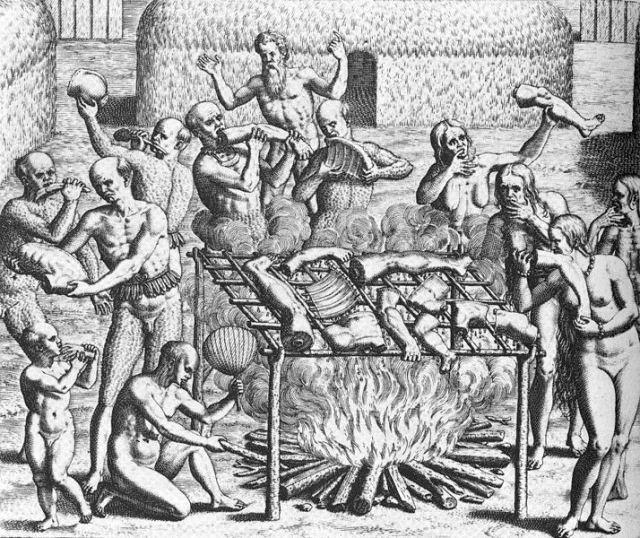
Os Filhos de Pindorama, shows Cannibalism in Brazil in 1557 as described by Hans Staden
Nevertheless, how the distinction is made and what is understood as a transgression differs: Whereas Volhard describes a cannibalistic ritual as an evidence of civilization, in colonial travelogues from the 18th century as the one cited above, the description of cannibalistic rituals serves as the reason to deny individuals of foreign tribes the status of human beings; one reason why it has to be questioned how much imagination and how much documentation the reports contain. The term cannibalism is closely linked to this colonial strategy of denial, as it came to life by a Spanish mispronunciation of the word ‹Caribs› that described native peoples of the Caribbean. So even if Volhard didn’t, one should actually differentiate between the terms cannibalism and anthropophagy. Cannibalism then does not only hint to a ritual act that frightened the morals of European humanity but also to a concept of racism and hegemony that should legitimate violence in colonies: In order to make the colony become like the home country – civilized, enlightened, rational and liberal – a mission was thought to be necessary. ‹The violent representation of the others as immovable different was a necessary part of constructing a sovereign, superior European self.›6 This legitimation for violence on its part frightened western postcolonialists, as it revealed the abysses of European Enlightenment and humanity morals.
Before postcolonial theory, between two wars and right before National Socialism that destroyed all persisted believes in the profound goodnessof humankind, Brazilian artist Oswald de Andrade (1890 – 1954) wrote the Manifesto Antropófago. He published it 1928 in the magazine Revista de Antropofagia that was edited by the Movimento Antropofagó, an artist movement that de Andrade was part of. The movement was founded subsequent to the ‹Semana de Arte Moderna›, the week of modern art, whichis commonly marked as the beginning of modern art in Brazil. There as well as in Europe, primitivism became an important theme. In Europe it served for the avantgarde’s questioning of tradition, origin and rationalism, whereas in Brazil cultural modernity was characterized by bethinking tradition : ‹Thus, primitivism developed to be a central topic in Brazilian art and literature by acknowledging the potentials of the own cultural foundations. The discourse about primitivism […] caused furthermore awareness forthe fact that the own culture and national contemporary art wasn’t subordinated to art from abroad but a representative means of export.›7
This movement aimed to rediscover and establish a Brazilian identity in its origins, even if this meant to understand the origin as a conglomerate of native entities and foreign influences, including colonialism as one ofits causes. De Andrade’s manifesto submits a way of handling these relations, the relation between the intrinsic and the extrinsic part of Brazilian culture – a not unproblematic relation, as the extrinsic in this case was (and is) highly linked to colonial oppression. But de Andrade smartly turns the perception of predominance of the foreign colonial influences into the possibility of Brazil’s culture own autonomy.
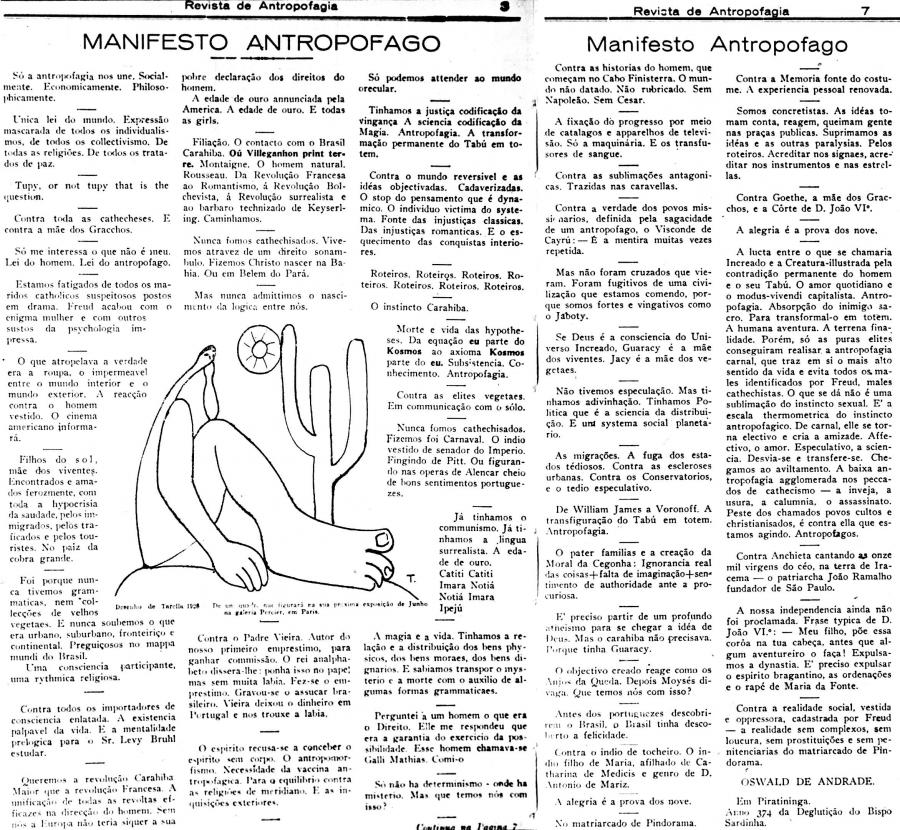
By eating the other, his8 strength transfers to the one who eats, it isa metamorphosis of energy. It is both an elimination by destroying the other, and an existential bond by incorporating him. By referring to this twofold dimension, de Andrade used anthropophagy as a metaphor of power: Already in the 16th century the Tupi, an indigenous people of Brazil, was discredited for cannibalism. And in 1928 de Andrade declares in an act of parody cannibalism as the power and potential of his culture:
‹Cannibalism alone unites us. Socially. Economically. Philosophically. […] We want the Carib Revolution. Greater than the French Revolution. The unification of all productive revolts for the progress of humanity. Without us, Europe wouldn’t even have its meager declaration of the rights of man.›9
De Andrade shows the problematics of a Eurocentric view that depicts the Brazilian cannibalists as barbarians, but is itself oppressive. Why not assimilating the stigmatization of barbarism, why not benefitting from it and eating up the oppressive enemies? Savagery is reformulated as something positive. But de Andrade goes much further, as Katrin H. Sperling points out: ‹The act of eating, digesting and excreting is meant as an allegory for the creative principle of dealing with and comprehending foreign cultural influences.›10 By arguing for an overaffirmative strategy of including and incorporating differences, de Andrade’s anthropophagist does neither reject European culture, nor does assimilation mean to surrender to the home countrycopy that the colonists wanted to create. The ‹dominant culture is not being tabooed but ritually devoured just as a feared totem animal. Power and energy thereby transfer to the consumer – the taboo becomes a totem.›11
De Andrade reflects not only the cultural situation of his country. He reflects upon how, in general, cultural relation can be accomplished. Inhis words, cannibalism is: ‹The world’s single law. Disguised expression of all individualism, of all collectivisms. Of all religions. Of all peace treaties.›12
The ironic gesture of generalizing a Eurocentric view on barbarism serves as a model for engaged creative assimilation of the foreign and as a ‹refusal of imaginations of cultural purity and the absolute affirmationof cultural plurality›13. Who defines center and periphery, native and foreign, me and the other – South America or western Europe? De Andrade’s cannibalistic view on ‹me and the other› provides an anthropophagic concept of identity, through and beyond the parody : It shows that negotiating identity is not an eitherorquestion. It is a process of the body, of ongoing fragmentation and composition, a performative practice that is brutal in both its materiality, its interdependency and its disrespect for a narrow sense of originality. This very disrespect for a pure originality is at the same time the caring for Menschlichkeit, as the manifesto reveals because it questions setting moral values.
Andrade does so by writing a manifesto which is itself anthropophagic, because it picks up, collages and parodies motives from both Brazilianand European culture. He refers to Sigmund Freud’s ‹Totem and Taboo› and to Shakespeare: ‹Tupi or not tupi, that is the question.›14
Thus the reflection upon Menschlichkeit doesn’t take place in the form of a rational dispute, but in a literally aesthetic of grotesque exaggeration and selfirony. ‹Being different becomes a strategy›15 –for a Brazilian barbarian, a Brazilian citizen as well as for the status as a Brazilian artist – a conscious deprivation of hegemonic power towards Europe and against selfimages of being a victim. De Andrade’s idea had an impressive impact on Brazilian culture – I already mentioned the Movimento Antropofagó – as well as across the continental borders, e.g. the European Dadaism was influ enced by it. And topically 2014, the 24. Brazilian Biennale’s theme was titled Cultural Anthropophagy.
A remark: The actuality of hegemonic struggles and colonialism in Europe is quite obvious. Today, at least some parts and people of Europe seem to be afraid of being colonized by Islam – whatever they take this term of Islam to mean. It goes to show the palpable power of parody and satire,a power likely embedded in art as well. A good thing, though made apparent by the shocking and sad events around the magazine Charlie Hebdo. Endof remark.
2. ‹me and the other› : individually and collectively
‹We are the proposers: our proposition is the dialogue. We do not exist alone.
We are at your mercy.
We are the proposers: we have buried the work of art as such and now ask you to let thought live through your action.›16
Another one that picked up the concept of anthropophagy is the Brazilian artist Lygia Clark (1920–1988). She was associated with the Tropicála, an artistic movement that followed the Movimento Antropofagó and its ideas. Clark herself cofounded the Brazil NeoConcrete movement in the 1950s, in which she and her colleagues declared that art should provide a subjective and organic experience. For Clark the subjective and organic status of art was to be found by experimenting with so called propositions. She began with painting and sculpture, then added writing and finally developed an interaction between visitors – she called them ‹participants› – and art work. She would later go on to therapeutic work, which she herself didn’t consider to be art.
Usually based in Rio de Janeiro, Clark was a teacher for ‹gestural com munication› at the Sorbonne in Paris between 1972 and 1975. There she found fertile ground for her sensual experiments as in Paris the 68’s movement was still in the air, a stark contrast to the Brazilian military dictatorship in any aspect. Here, she didn’t need a museum or gallery space anymore, the best laboratory was in a classroom or on the street. She wanted people to experience radically; even the format of the Happening that she found temporally and categorically limited was not fitting. Furthermore, she could not identify with the movement of Modern Body Art and its destruction of authorship, spectatorship and objecthood: In her opinion its protagonists weren’t going far enough, because they still needed an object and a classical subject-object relation in order to destroy it.17
In 1973 Clark created the proposition Baba antropofágica (Anthro pophagic slobber), that she described in a letter to Brazilian friend and artist Hélio Oiticica:
‹A person lies on the ground. The others, kneeling around this person, put in their mouths spools of thread of various colors. With their hands they start pulling out the threads until the spool is emptied on the person lying down. The line comes out full of saliva and the people who pull it out start by feeling that they are simply pulling a thread, but next comes the perception that they are taking out their own viscera. It is the phantasmatic of the body, as a matter of fact, that interests me, not the body itself. […] A kind of struggle begins that is the defoulement to break the drool [when the ones who where pulling the thread remove it] – which is done with aggression, euphoria and joy and even pain […].›18
The performance is a process of fragmentation, assemblage and reconfiguration: fragmenting the participants’ bodies into secretions, organs, imaginations, then collaging them and thereby structuring a collective body. Nearly no skin contact happens but participants tell that there still is an even stronger perception of proximity and ‹insideoutside reversibility›.19 By making a multicolored mesh as a second skin, removing and expanding it and finally rupturing the cocoon, a sense of creation and circulation emerges. The effect is a ‹suspension of psychophysical habits, the expansion of sensorial capacities, and the stimulation of perception as relation›20. Clark believed that the phantasmatics she talked about in the cited letter above are withholding suppressed forces, and Clark wanted to access them through kinds of collective practices. She believes them to stimulate the emancipa tion of the body.
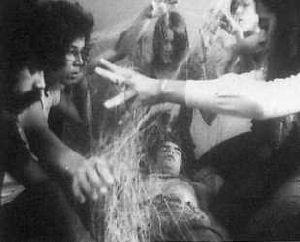
I haven’t mentioned the final and essential part of the proposition yet: the vivencias, the sharing of and talking about the experiences. Clark con sidered to be them more than everyday communication but attributed them psychological qualities. The former process is meant to be a bodily encounter which then enables a sculpting with words, a search for verbalization.
Each individual experiences different narratives in a yet collective practice that works as a ritual which does not refer to a myth, but creates one, more precisely said creates multiple individual ones. Eleonora Fabiao formulates:
‹She [Lygia Clark] seeks the shared experience of embodied narratives and verbal touch for the decolonization of the body. She wants the exchange of secretions and secrets through cannibalistic speech and hearing acts of mutual incorporation. Anthropophagy here does not intend dispute, capture, or domination. It involves struggle, but in a process of exchange […].›21
Clark’s use of anthropophagy picks up de Andrade’s idea of interweaving and incorporating diverse perspectives, his idea of a creative and engaged mixture, but she ‹digests› the manifesto in her own way, as the above cited article felicitously puts it. To the questioning of common and hegemonic dualities Clark adds a new awareness for the body that characterized the 1960s–‹a body that would be oppressed and restricted under the dictatorship but would find expression and release through new, participatory, engaged forms of art›22. For Clark anthropophagy was not anymore a metaphor in literature, but an impulse for an emancipatory cultural practice including body, slobber, salvia, color and psychological imaginary states – a process that ended in the struggle of a verbalized dialogue.
‹Alone we do not exist›23, she said. Not a very spectacular discovery, still it helps to make clear that for her the collective exchange is more carnal and existential and less ironic than in de Andrade’s manifesto. Still both, Baba antropofágica and the Manifesto Antropofágica, show that the const ruction of identity, individually and collectively, is a constant back andforth – within cultural influences, but also within a process of verbalization and the constant making of the body.
Lygia Clark’s approach is a negotiation of the relation of ‹me and the other›. In a practical bodily and then reflecting practice with her students and participants, the relation to the other person, but also between subjectand object, is seen as one of creative agency. In her pieces, acts that might be seen as strange, fleshly or even crazy, irrational and highly subjective are part of the construction of human beings and their surroundings. In 1973 this concept of art was different to other established understandings of whata work of art is. It also differed from ideas associated with European Enlightenment, humanity and anthropology at her time. Is Clarks abandonmentof art as objects linked to the abandonment of concepts about the socalled enlightened subjectivity? Does this tell us that reflecting about art goes along with concepts of what the concept of being a human is? I state that it can. Artistic practice has a value concerning the perpetual negotiation of Menschlichkeit.
3. ‹me and the other› : anthropocene and anti-human
‹How do we want to live after disaster strikes (if we survive)?›24
The structural approach to culture of Claude Lévi-Strauss, a French anthropologist, opened up a related way to value foreign and so called primitive ways of living. He criticized the Eurocentric claim for being high culture – and his influence does actually question Kosuth’s observation of 1975 that only artistic anthropology can alter society. In 1955 Lévi-Strauss wrote about the Tupi and used, comparing them to Europe, two opposing terms: anthropophagy and ‹anthrophemie›25. The first means, as we already know, an act of, literally, incorporating the foreign and dangerous, and the latter, an act of excluding, vomiting the ‹other›. The term of anthropophagy is not used in order to subordinate the other non-European, in his concept it even seems to be qualified more clever and positive than the European ‹anthrophemie›. Therefore, we see that the concept of cannibalism can also serve as a way to question Eurocentric hegemony from an European view. And what happens today?
Body, performance, materiality, sensuality, collectivity etc. are motives that as we saw Lygia Clark advanced – and that nowadays are reappearing motives in western art, in humanities as well as in healthcare and life concepts. It seems that, polemically, deep doubts about the rightfulness of the values of western neoliberal societies are emerging, the way in which one looks at incorporate nonwestern cultures and practices. We do Yoga, buddhist meditation, throw ourselves into vehement critique of the logic of capitalism, reveal capitalism’s conspiracy with rationalism and we appropriate skills in feeling, getting wise and forming local collectives. We try to over come the opposition of ‹me and the other›, still inherent in Lévi-Strauss’ observation. You might already suspect that at this point in this last chapter I hint at a bigger scale catastrophe and will go beyond artistic anthropophagy. Because, despite meditation and energetic skills, the diagnosis is done: through centuries, western states and Eurocentrism exploited others and themselves and developed a capitalism that now is the uncontrollable savage that will eat us all up. Capitalism and exploitation have led us into a new era: we live in the Anthropocene.
‹Every living thing affects its surroundings. But humanity is now influencing every aspect of the Earth on a scale akin to the great forces of nature. / There are now so many of us, using so many resources, that we’re disrupting the grand cycles of biology, chemistry and geology […] Almost all the planet’s ecosystems bear the marks of our presence. / Our species’ whole recorded history has taken place in the geological period called the Holocene – the brief interval stretching back 10.000 years. But our collective actions have brought us into uncharted territory. A growing number of scientists think we’ve entered a new geological epoch that needs a new name– the Anthropocene.›26
That’s how concerned scientists explain the term themselves. The human being is a big manipulating influence on earth. Yet, is there a clear idea of what this human being is? The sociologist Dietmar Kampe argued in 197327, the same year that Lygia Clark was spooling slobber threads, that Enlightenment was a kind of anthropological theory that took premises about the essence of human subjectivity for granted. The critique of these premises by NeoMarxism, Critical theory and Existentialontology – I won’t go further into these concepts now – resulted in a so called negative anthropology: There should not be a final conception of the human being. What is the consequence? Yoga in order to find our individual selves? But let’s leave sarcasm: By focusing on the body and its material, unpredictable and collective dimensions, the Brazilian concept of anthropophagy has reflected upon radical ways of interpersonal and intercultural relations much earlier than negative anthropology. Therefore, the consequence could be: act a bit more anthropophagic in the sense of a radical bodily dialogue. Not just a theoretical dialectical dialogue, but also a practical one.
But there is another possible consequence.
The fatal but imaginable prognosis is that there might be another world war coming, caused by the consequences that the scientists’ description above is hinting at: climate change, end of resources, water poisoning, epidemics, hyperinflation etc. ‹The end is near […] official media and conspiracy theorists all agree: Something will happen. Soon. What to do?›28
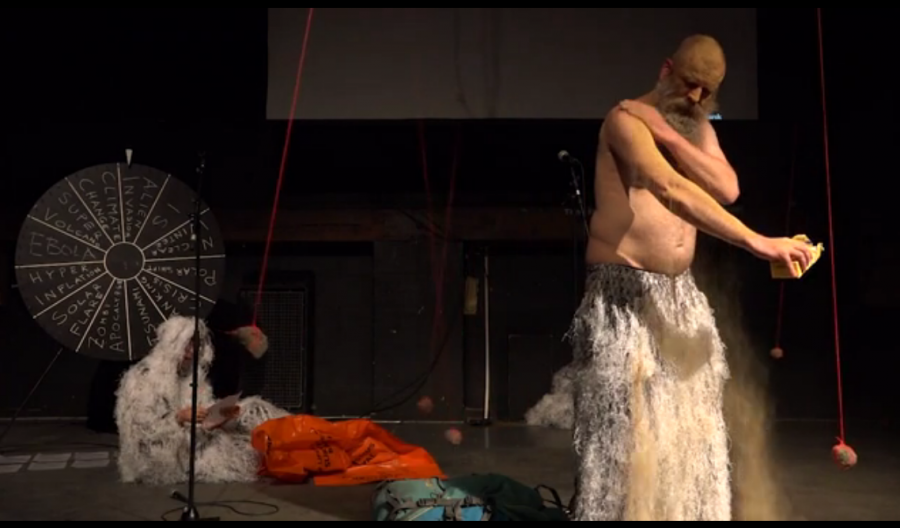
This sentence is taken from the performance TEOTWAWKI. Trainingseinheiten für das Ende der Welt (wie wir sie kennen)29 by Jörn J. Burmeister and Florian Feigl. At the beginning of the performance, after all the visitors have been let into an area barred by hoardings, a big panel that looks likea wheel of fortune decides about which catastrophe is going to happen. When I saw the piece in October 2014 at Sophiensäle in Berlin, we found out that the poles of the earth will reverse. In the next step the performers talk about the preppers, ‹a rapidly growing movement of mostly white, hetersexual, affluent Americans, who expect very concrete catastrophes and get ready for them : They build nuclear fallout shelters, make tomato preserves, stockpile machine guns and armor their SUVs›30.
Moreover, the performers started to play an absurd scenario of getting prepared. But they also ask for alternatives and refer to the ideas I mentioned in the beginning of this chapter : ‹Will all those models of fair, egalitarian, collaborative living together that we experimented with for the last20 years be worth anything, or are they merely a luxury capitalism grants us to keep us quiet?›31
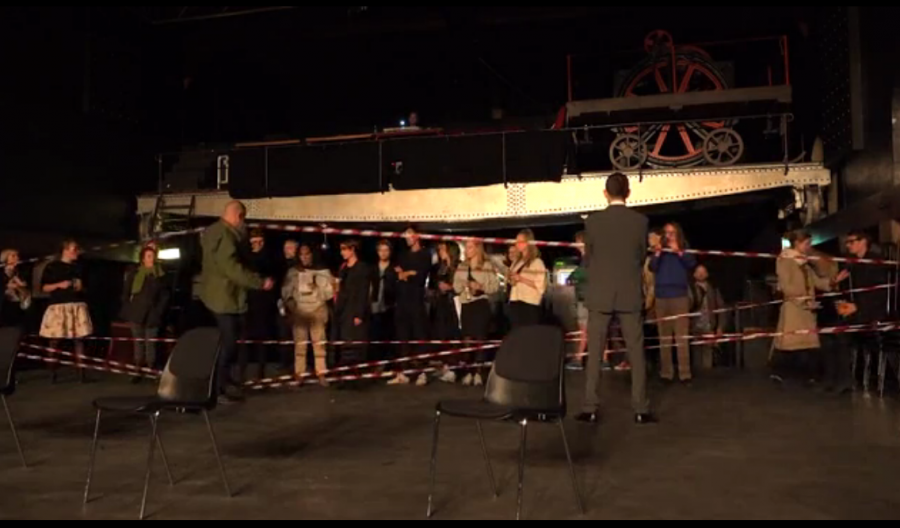
In the very end, after running in circles and flooding with projected im ages of crises, one of the performers announces a decision: Rather than, after trying to live collectively and falling back into the same mechanisms again, he quits calling himself a human being. The relation ‹me and the other› will fail again. Menschlichkeit will not succeed.
Burmeister and Feigl remind us of a crucial point that constitutes Menschlichkeit : Our possibility and impossibility to make a decision. On the one hand, they show that the freedom to decide is sometimes more a burden to carry than a pleasing status. And on the other hand the performance shows how absurdly freedom binds us to a constricting will for control and power. By this, Burmeister and Feigl reveal art as a place for negotiating Menschlichkeit. They define art as a place for reflecting upon and constituting human practice, as Kosuth argued, by making it a place for radical and satiric claims for uncertainty.
We will never be able to decide wether we are free to decide. But we can make a decision to keep on caring for the relation of ‹me and the other›, and that means to keep caring for Menschlichkeit as a negotiable notion,as an infinite and fallible, bodily and reflectively process. Within this process we should never forget the premises of our own actions, but we should also never forget to be aware of and use our organs and flesh.
- 1. The reasons why I use the German version are exemplified in the editorial of #1.
- 2. Joseph Kosuth: ‹Artist as Anthropologist›, 1975.
- 3. Joseph Kosuth, 1975.
- 4. Richard H. Major (ed.), Chanca, in: Hedwig Röckelein (ed.): ‹Kannibalismus und europäische Kultur›, 1996, p.120.
- 5. Röckelein, 1996, p.9.
- 6. Maria Do Mar Castro Varela und Nikita Dhawan: ‹Postkoloniale Theorie. Eine kritische Einführung›, 2005, p.16 (‹Die gewaltvolle Repräsentation der Anderen als unverrückbar different war notwendiger Bestandteil der Konstruktion eines souveränen, überlegenen europäischen Selbst.›, translation by Mira Hirtz).
- 7. Maria Do Mar Castro Varela und Nikita Dhawan, 2005, p.185 (‹So entwickelte sich der Primitivismus im (An-)Erkennen der Potentiale eigener kultureller Grundlagen zu einem zentralen Thema in der brasilianischen Kunst und Literatur. Der durch die Kulturanthropologie, die Psychoanalyse, die Philosophie und die Avantgarde-Bewegungen transportierte Primitivismusdiskurs führte in Brasilien darüber hinaus zu dem Bewusstsein, dass die eigene Kultur und die nationale Gegenwartskunst der ausländischen Kunst nicht untergeordnet war, sondern ein durchaus repräsentatives Exportmittel darstellte.›, translation by Mira Hirtz).
- 8. If we can believe the travelogues, females haven’t been eaten by the South American cannibalists, but been used for giving birth. Whereas in ethnological and archeological research it is questioned if the cannibalistic ritual ever took place, there and in general. See : Röckelein, 1996.
- 9. translated by Leslie Bary, http://www.corner-college.com/udb/cproK3mKYQAndrade_Cannibalistic_Manife…
- 10. Katrin H. Sperling: ‹Nur der Kannibalismus eint uns. Die globale Kunstwelt im Zeichen kultureller Einverleibung: Brasilianische Kunst auf der documenta›, 2011, S. 194 (‹Der Vorgang des Verzehrens, des Verdauens und des Ausscheidens versteht sich als Allegorie für das kreative Prinzip der Auseinandersetzung mit und des Einbeziehens von fremden kulturellen Einflüssen. Der durch die europäische Moderne stimulierte Primitivismus, der Mythos des barbarischen Wilden, erfährt hier eine Umkehrung, eine positive Re-Formulierung.›, translated by Mira Hirtz).
- 11. Sperling, S. 194 (‹Die Gleichzeitigkeit von Ablehnung und Aufnahme der Kultur der Kolonialherren erweist sich nicht etwa als Widerspruch, sondern als Kernstrategie der modernen Anthropophagen. Die dominante Kultur wird nicht tabuisiert, sondern wie ein gefürchtetes Totemtier rituell verschlungen. Kraft und Energie gehen damit auf den Konsumenten über – das Tabu wird zum Totem.›, translated by Mira Hirtz).
- 12. translated by Leslie Bary, http://www.corner-college.com/udb/cproK3mKYQAndrade_Cannibalistic_Manife…
- 13. Sperling, p.189 (‹[…] Absage an Vorstellungen kultureller Reinheit sowie für die absolute Bejahung kultureller Pluralität.›, translated by Mira Hirtz).
- 14. translated by Leslie Bary, http://www.corner-college.com/udb/cproK3mKYQAndrade_Cannibalistic_Manife…
- 15. Sperling, p.195 (‹Anders sein wird zur Strategie.›, translated by Mira Hirtz).
- 16. Lygia Clark: ‹We are the proposers›, 1968.
- 17. cf. Lygia Clark: ‹The Abandonment of Art›, 1948 – 1988, exhibition catalogue, The Museum of Modern Art, 2014, p.296.
- 18. Letter to Hélio Oiticica, 1974.
- 19. The author of the cited article, Eleonora Fabiao, talks about her own experiences: Lygia Clark: ‹The Abandonment of Art›, 1948 – 1988, exhibition catalogue, The Museum of Modern Art, 2014, p.297.
- 20. ib., p.207.
- 21. Lygia Clark: ‹The Abandonment of Art›, 1948–1988, exhibition catalogue, The Museum of Modern Art, 2014, p.298.
- 22. ib., p.14.
- 23. Lygia Clark: ‹The Abandonment of Art›, 1948-1988, exhibition catalogue, The Museum of Modern Art, 2014, p.298 and citations inside: Lygia Clark, untitled text in exhibition catalogue from 1998.
- 24. http://www.sophiensaele.com/produktionen.php?IDstueck=1257, date of query 22.01.2015.
- 25. cf. Claude Lévi-Strauss: ‹Triste Tropique›, 1955.
- 26. http://www.anthropocene.info/en/anthropocene, date of query 22.01.2015.
- 27. Dietmar Kampe: ‹Geschichte und menschliche Natur. Die Tragweite gegenwärtiger Anthropologiekritik›, 1973.
- 28. http://www.sophiensaele.com/produktionen.php?IDstueck=1257, date of query 22.01.2015.
- 29. ‹training sessions for the end of the world (as we know it)›, translated by Mira Hirtz.
- 30. http://www.sophiensaele.com/produktionen.php?IDstueck=1257, date of query 22.01.2015.
- 31. http://www.sophiensaele.com/produktionen.php?IDstueck=1257, date of query 22.01.2015.